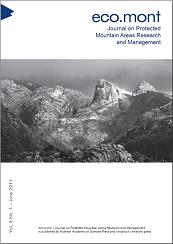Gabriele Kraller,
Ulrich Strasser,
Helmut Franz
S. 19 - 28
doi:
10.1553/eco.mont-3-1s19
Verlag der Österreichischen Akademie der Wissenschaften
doi:
10.1553/eco.mont-3-1s19
Abstract:
The Berchtesgaden Alps are situated in the Northern Limestone Alps, characterized by individual mountain plateaus and ridges in close proximity to each other, intersected by valleys, with an altitudinal gradient of 2 100 meters. The limestone has been exposed to dissolution processes since the Cretaceous, leading to a massive karstified aquifer with a wide range of subsurface flow channels. There are hundreds of springs as groundwater recharge locations, feeding the seven rivers of the region that contribute to the Danube watershed. Several studies were conducted to examine the hydro-geological conditions and the resulting groundwater flow. This paper aims to evaluate and summarize research in the basin describing groundwater flow to identify the main drainage direction, travel times, spring dynamics and possible subsurface redistribution in the individual mountain ranges and the whole basin. To this end, we evaluate several tracer experiments, two isotope studies and a spring database. The tracer experiments are generating knowledge about flow directions in the individual mountain ranges, groundwater redistribution, water storage and mean travel times. Five experiments prove increased groundwater flow remaining within a valley and four experiments indicate groundwater redistribution through mountain ranges. The isotope studies indicate potential water storage in the Wimbach valley of an estimated 100 x 106 to 470 x 106 m3 and mean transit times of about four years. The analysis of the spring database focuses on locations and discharge classification. Overall, there are 289 springs recorded in the spring database, distributed from 600 to over 2 000 m altitude, with major springs at the northern base of the mountains Hochkalter, Watzmann and at the north shore of lake Königssee. The conclusion summarizes the effect of the karst aquifer on the hydrology of the region. The outlook introduces current research within the area and the distributed water balance modelling.
karst tracer isotope groundwater-flow distributed-water-modelling regional scale, integrated-water-resource-management
Published Online:
2011/05/19 14:13:05
Document Date:
2011/05/19 14:12:00
Object Identifier:
0xc1aa5576 0x0028afa4
Rights:https://creativecommons.org/licenses/by-nc-nd/4.0/
The journal “eco.mont” – Journal of protected mountain areas research and management – was published for the first time in June 2009.
The journal was founded as a joint initiative of the Alpine Network of Protected Areas (ALPARC), the International Scientific Committee on Research in the Alps (ISCAR), the Austrian Academy of Sciences (ÖAW) and the University of Innsbruck.
The journal aims to highlight research on and management issues in protected areas in the Alps without excluding other protected mountain areas in Europe or overseas. Its target audiences are scientists from all related disciplines, managers of protected areas and interested individuals including practitioners, visitors, teachers, etc.
The journal presents peer-reviewed articles in English by authors who research protected mountain areas and management issues within these areas. It's published twice a year as a collaboration of the Austrian Academy of Sciences Press – responsible for the e-version – and Innsbruck University Press – responsible for the print version.
Die Zeitschrift „eco.mont“ – Zeitschrift zur Forschung in Gebirgsschutzgebieten – erschien im Juni 2009 zum ersten Mal. Die Zeitschrift wurde auf Initiative des Netzwerks Alpiner Schutzgebiete (ALPARC), der Schweizer Akademie der Naturwissenschaften (ISCAR), der Österreichischen Akademie für Wissenschaft (ÖAW) und der Universität Innsbruck gegründet. Sie hat das Ziel, Themen zu behandeln, die gleichzeitig Forschung und Verwaltung in und über die Schutzgebiete der Alpen betreffen, ohne dabei andere Gebirgsschutzgebiete Europas oder anderswo auszuschließen. Diese neue Zeitschrift richtet sich an ein Publikum von Wissenschaftlern der verschiedensten Fachbereiche, an die Verwalter von Schutzgebieten und an alle sonstigen Interessierten, Praktiker, Besucher, Lehrpersonal etc. einbegriffen. Die Zeitschrift veröffentlicht begutachtete Beiträge auf Englisch von Autoren, die Fragen der Gebirgsschutzgebieten und deren Verwaltung forschen. Sie erscheint zweimal pro Jahr, auf der Basis der gemeinsamen Anstrengungen des Verlags der Österreichischen Akademie der Wissenschaften, der für die digitale Fassung verantwortlich ist, und der Presse der Universität Innsbruck, verantwortlich für die gedruckte Fassung.



 Home
Home
 Print
Print
 References
References
 Share
Share

